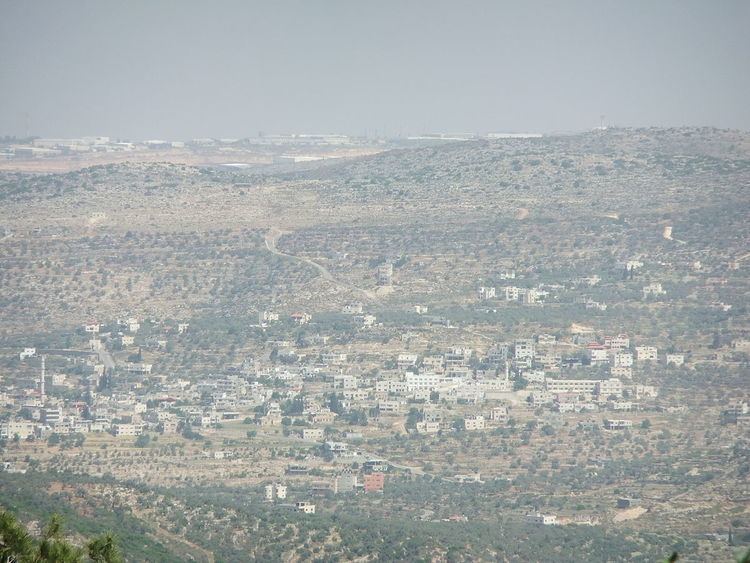Palestine grid 162/162 | ||
 | ||
Name meaning The towns of Ibn Zeid, in the Beni Zeid district Weather 17°C, Wind SW at 18 km/h, 60% Humidity | ||
Qarawat Bani Zeid (Arabic: قراوة بني زيد) is a Palestinian village in the Ramallah and al-Bireh Governorate, located 22 kilometers northwest of Ramallah in the northern West Bank. According to the Palestinian Central Bureau of Statistics (PCBS), Qarawat Bani Zeid had a population of 2,915 inhabitants in 2007. Qarawat Bani Zeid is under the complete control of the Palestinian National Authority, as it is located within "Area A".
Contents
- Map of Qarawat Bani Zeid
- Etymology
- History
- Ottoman era
- British Mandate era
- 1948 1967
- 1967 and after
- Economy
- Government
- References
Map of Qarawat Bani Zeid
Situated close to the village mosque is the remains of a Roman pool, about 60 meters underground.
Etymology
Qarawat Bani Zeid is named after the Arab tribe of Bani Zeid, that settled in the town after the Muslim Ayyubid victory against the Crusaders in 1187. The "Qarawat" portion of the name comes from the Arabic word Qaran, which means "central point", originating from the site's location between the major cities of Nablus, Jericho and Jerusalem. There is also speculation that the name comes from Qira, which means "place that respects guests". According to Palmer, the name means "he towns of Ibn Zeid, in the Beni Zeid district."
History
Potsherds from IA I-II, IA II, lA II/ Persian, Persian, Hellenistic, Hellenistic/Roman, Roman, Byzantine, Crusader/Ayyubid and Mamluk era have been found in the village.
Ottoman era
In 1517, the village was included in the Ottoman empire with the rest of Palestine, and in the 1596 tax-records it appeared as Qarawa, located in the nahiye of Quds (Jerusalem) in the sanjak of the Mutasarrifate of Jerusalem. The population was 32 households, all Muslim. They paid a tax rate of 33,3% on agricultural products, which included wheat, barley, olive trees, vineyards and fruit trees, occasional revenues, goats and beehives; a total of 24000 Akçe. Potsherds from the early Ottoman era have been found.
In 1869, Victor Guérin found the village to have 300 inhabitants. He also noted a fragment of an ancient pillar.
An official Ottoman village list of about 1870 showed that Karawa had a total of 48 houses and a population of 200, though the population count included men only.
In 1882, the Palestine Exploration Fund's Survey of Western Palestine (SWP) described is as "a small village on a knoll, with ancient tombs, and a tank, surrounded with olives."
British Mandate era
In the 1922 census of Palestine, conducted by the British Mandate authorities, Karawa Beni Zaid had a population of 274, all Muslims, increasing in the 1931 census to 394, still all Muslims, in a total of 88 houses.
In 1945 the population was 500, all Muslims, while the total land area was 5,100 dunams, according to an official land and population survey. Of this, 3,421 were allocated for plantations and irrigable land, 219 for cereals, while 21 dunams were classified as built-up areas.
1948-1967
In the wake of the 1948 Arab–Israeli War, and after the 1949 Armistice Agreements, Qarawat Bani Zeid came under Jordanian rule.
1967, and after
After Six-Day War in 1967, Qarawat Bani Zeid has been under Israeli occupation.
Economy
Qarawat Bani Zeid's main economic sectors are agriculture and traditional industries. The village's land area consists of about 8,000 dunams, 30% of which is built-up area, another 30% is covered with crops or orchards and the remaining 40% consists of either unused land or roads. The main crops that are grown are lentils, vegetables, thyme (za'atar) and sage. Grapes, as well as olive and fig orchards are also grown in the village lands. Traditional industries include basket weaving from olive wood, wool and leather-making and food manufacturing, particularly cheese.
About 60% of the village's working population are unemployed. The 40% that are employed work mostly in farming, simple commerce or teaching. However, some inhabitants work in government offices in Ramallah. There are two mosques, a hammam, a library, a social club for teenagers and a women's club in Qarawat Bani Zeid.
Government
Qarawat Bani Zeid is governed by a village council. Elections are not held; rather, the council — which has representatives from the village's prominent families — select a mayor. The primary political faction is the Palestinian People's Party (PPP) and Fatah, Hamas and the Popular Front for the Liberation of Palestine (PFLP) have minor influence in the village.
